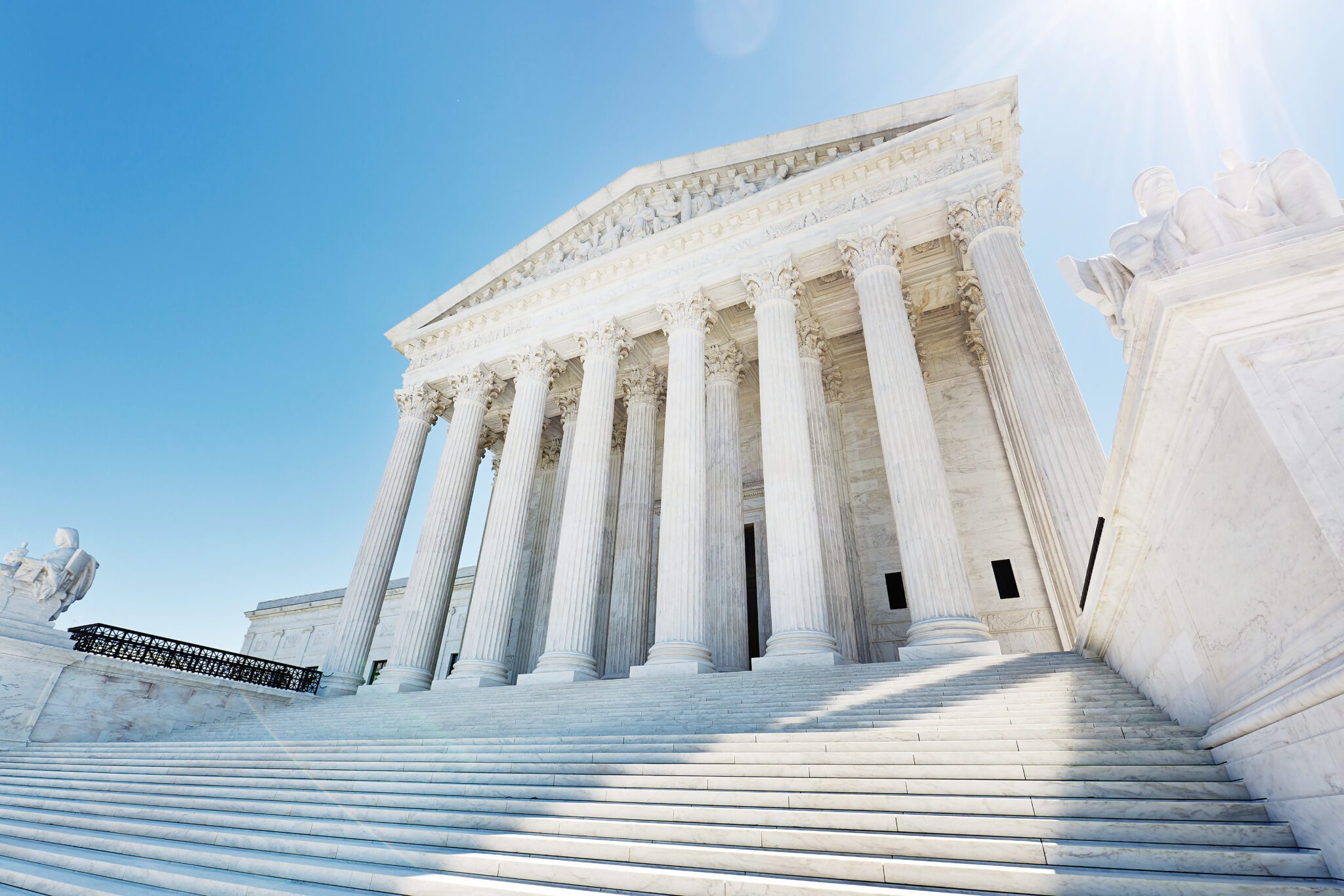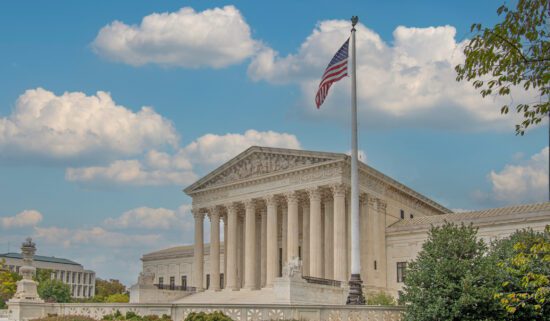This Tuesday, April 28, 2015, the Supreme Court of the United States will hear oral arguments in four consolidated cases, all of which deal with the issue of same-sex marriage. It promises to be a “landmark case,” whichever way it is decided. In all likelihood this will be the Roe v. Wade of the current generation.
In cases of such cultural and legal significance, it is important for Christians to understand the arguments that are being presented. While we may have a strong theological grasp of why marriage—biblically defined—consists of a lifelong monogamous union between one man and one woman, the legal arguments concerning the constitutionality of state marriage laws is a different issue. Yet I believe that Christians should endeavor to stay informed and active in civic engagement, especially in cases like these. Though not everyone can be a constitutional scholar, anyone willing to pay attention and think critically can understand the applicable laws and principles of this case. My aim is to communicate the legal argument in favor of states with same-sex marriage bans in a way that is understandable by the ordinary person with no legal training whatsoever.
First, we must understand what is the issue, legally, that the Court will decide. The constitutional issue is not whether same-sex marriage is good or bad. Nor is it whether the view of traditional marriage is the right view. There is no constitutional argument that heterosexual marriage should be the norm for the entire nation. The issue in this cases is whether the Constitution requires states to recognize same-sex marriages. Or, to put it the other way around, does the Constitution allow each state to define marriage for itself? A careful consideration of the Constitution and relevant cases reveals that yes, each state can define marriage for itself. Consequently, the Constitution does not require every state to recognize same-sex marriages. So let’s dive into the argument. The following Question Presented is from Petitioners’ (i.e., individuals seeking same-sex marriages) brief:
QUESTION PRESENTED: (1) Does the Fourteenth Amendment require a state to license a marriage between two people of the same sex?
A legal analysis of this question generally has three parts:
Do states have the authority to define marriage? If so, are there any constitutional constraints?
Do the state marriage laws at issue violate the 14th Amendment’s Due Process clause?
Do the state marriage laws at issue violate the 14th Amendment’s Equal Protection clause?
If the answer to either questions two or three are yes, then the state laws are unconstitutional. But let’s start with question number one: Do states have the authority to define marriage? And if they do, what constitutional restraints apply to those definitions?
State Authority to Define Marriage
States traditionally have enjoyed the right to define and control the institution of marriage. Since our nation’s founding, states have overseen the civic institution of marriage, conferring benefits and establishing consequences for the breakup of marriages. The US Constitution, however, does not set a national standard for marriage that all states must follow. Simply put, the Constitution is silent on the issue of marriage; therefore, the power to regulate and define marriage is left to the states as part of their general sovereign authority.
Several Supreme Court cases have upheld and reaffirmed the state’s integral role in defining and regulating marriage. For more extensive reading on the history of the state’s involvement in marriage, the State of Utah’s Petition for Certiorari in a similar marriage case is worth a read.
More recently, however, the Supreme Court addressed this very issue in the “DOMA” case, often called the Windsor decision. This case struck down as unconstitutional the federal Defense of Marriage Act, in which the federal government refused to recognize or confer benefits to same-sex married couples. In reaching its decision to invalidate the law, the Supreme Court relied on the bedrock premise that states controlled marriage, not the federal government. In other words, the Court held that the federal government could not refuse to recognize state-sanctioned same-sex marriages precisely because the power to define and police marriage lies with each state.
Although this decision was lauded as a victory for LGBT rights, the underlying principle of the case cuts against Petitioners here. Either Windsor was incorrectly decided (and thus requires reversal), or the states can define marriage for themselves, and Petitioners’ argument fails. Simply put, our nation has a longstanding history and tradition of conferring the marriage power to states, and a decision contrary to that would fly in the face of a long list of settled legal precedent.
Even though states have the authority to define marriage, those definitions are subject to constitutional constraints that apply to all other state laws. In other words, state marriage laws must follow the constitutional protections guaranteed by the 14th Amendment (which makes most federal constitutional rights applicable to the states). This takes us to question number two: do the state laws in this case violate the 14th Amendment’s Due Process clause?
Fundamental Rights Analysis
The 14th Amendment to the Constitution generally prohibits the government from infringing upon a person’s life, liberty, or property without due process of law. Over time (and through much debate, but not a topic for this article), the Court has understood this provision of the Constitution to protect a person’s fundamental liberties from being infringed upon by the states. It is a “substantive rights” guarantee. The Constitution, however, does not specify what fundamental liberties, or “rights,” a person has. So, the Court looks to our nation’s history and tradition to determine if there is a fundamental right at stake. If there is a fundamental right at issue, then the law must be narrowly tailored to further a compelling governmental interest, using the least restrictive means available. This is called the “strict scrutiny” test, and it is a high burden to overcome.
The first step in fundamental rights analysis is to determine what is the “right” being addressed. Then, once the right is named specifically, the Court will determine if that right is “fundamental,” i.e., a constitutionally protected liberty interest. A right is fundamental in American law if it is “so deeply rooted” in our nation’s history and tradition as to be implicit to the concept of ordered liberty. (Unfortunately, the existence or non-existence of these rights depends upon the makeup of the Supreme Court.)
If, however, the identified right is not a fundamental right, then the Court applies the “rational basis” test to the law. Under rational basis review, the law must simply bear a rational basis to furthering a legitimate government interest. It is a fairly low standard of review—most laws withstand this test.
Let’s consider the fundamental rights analysis with respect to the current marriage cases before the Court. In the Petitioners’ written brief, they describe the right at issue as “the right to marry the one adult of their choice,” regardless of gender. To be sure, the wording is crafted carefully and intentionally. According to Petitioners, though, this right—as stated—is fundamental to American liberty. But let’s consider this assertion in the light of our nation’s history and tradition.
The 14th Amendment, on which the Petitioners rely, was adopted in 1868. At that time, no state recognized same-sex marriages. In fact, no sovereign nation in the entire world allowed same-sex couples to marry until the year 2000. In America, the first state to allow same-sex marriage (Massachusetts) did not do so until 2004—a mere decade ago. Therefore, it is a far stretch of the imagination to assert that the right of persons to marry the one adult of their choice—independent of gender—is “so deeply rooted in our nation’s history and tradition” as to be implicit to the concept of ordered liberty. Ordered liberty has flourished in this country for nearly 250 years without same-sex marriage. If anything, one could say that sexual complimentarity in marriage is deeply rooted in our nation’s history and tradition, not same-sex marriage. To say that it is a fundamental right does not line up with what, by definition, constitutes a fundamental right. The Supreme Court has used this line of reasoning as recently as the Windsor decision.
Moreover, the Petitioners did not provide any limiting principle to this fundamental right to marry other than that it be the “one” person that another person chooses to marry. But this ignores other longstanding prohibitions against marriage choice that operate as legitimate (and unquestioned) constraints on marriage options. For example, most—if not all—states have some sort of law prohibiting marriage between, say, brother and sister. These “consanguinity” laws remain unchallenged, yet they clearly operate against the Petitioners’ definition of the fundamental right to marry. There are other examples, but the point is that the freedom to marry whomever one wants is not deeply rooted in our nation’s history and tradition. Same-sex marriage, therefore, is not a fundamental right guaranteed by the Constitution.
So, if same-sex marriage is not a fundamental right, the Court should apply the rational basis test, where the law must bear some rational basis related to furthering a legitimate government interest. But even under this test, the Petitioners argue that same-sex marriage bans bear no rational relationship to a legitimate government interest. Instead, they argue that bans on same-sex marriage are based solely on an arbitrary animus towards same-sex sexual relationships and homosexual individuals. A closer look at what marriage is, and its relationship to an ordered civil society, however, reveals that this claim is false. Even more, an honest look at the historical record reveals that traditional definitions of marriage are not based on an animus towards gays and lesbians. Indeed, throughout history, societies that were notably tolerant of homosexual behavior still defined marriage as between one man and one woman. For an extended discussion on this topic, I recommend Ryan T. Anderson’s lecture at Franciscan University on the uniqueness of man-woman marriage and its role in society.
Simply put, the government has a legitimate interest in the success of the family as the foundation of a civil society. Many states, relying on voluminous social science data, have concluded that a married mother and father under one roof is the most stable and healthy environment in which to raise children. The unique advantages that a sexually complimentary marital relationship provides for children is well-documented and extensive. Petitioners, though, largely ignore this data. So, in order to promote a flourishing family structure and society, several states have defined the marriage relationship to be the heterosexually monogamous relationship between one man and one woman. True, not all couples have children, and many couples who desire children cannot have them. But the fact remains that man-woman marriage is the preferred family situation for raising any children that may result from a marital union. Excluding the requirement of sexual complimentarity in marriage ignores this biological and teleological reality. Governments, therefore, have endeavored to create a structure in which families and children can thrive. Surely the government has at least a legitimate interest in providing a culture in which families can flourish and children can thrive.
In order to pass muster, then, the state’s law must bear a rational relationship to this interest. Clearly, defining marriage as between a man and a woman is rationally related to the government’s objective of promoting a stable and productive family atmosphere. This is a low standard, but the positive relationship between stable family environments and a stable and productive society is well documented—and rational. Petitioners, however, must go so far as to say that this relationship, and the belief that children deserve the chance to be raised by both mother and father, is completely irrational. Completely irrational! This is a bold claim. Taken to its logical end, Petitioners must affirm that millenia of experience and social science are completely irrational and meaningless.
The truth is that state laws defining marriage as between a man and a woman do have a rational basis in furthering a legitimate government interest. The state laws, therefore, withstand the fundamental rights analysis. On to question three: do the states’ laws violate the Equal Protection clause?
Equal Protection Analysis
The next part of the analysis focuses on the Equal Protection clause of the 14th Amendment, which says that no state shall deny any person “equal protection of the laws.” Historically, this has been understood to prohibit discrimination on the basis of race. All laws should apply equally to all people, regardless of race. Under modern Equal Protection analysis, however, there is a two-part test.
The first element of the test seeks to determine if the law disfavors, or treats differently, a protected class of persons. “Protected class” status has traditionally been reserved for classifications based on race, and to some extent, sex. If a law treats members of a protected class differently, then the Court will apply the “strict scrutiny” test mentioned above. If there is a “quasi-protected class,” such as a classification based on sex (or sexual orientation, as argued by Petitioners), then the court will use an analysis called “intermediate scrutiny.” In order to meet the heightened scrutiny standard, a law must be “closely related” to an “important government interest.” And if there is no protected class, the Court will apply the rational basis test.
Petitioners in this case mount an attack on marriage laws on two separate fronts. First, they argue that same-sex marriage bans discriminate on the basis of sexual orientation, and that sexual orientation discrimination should trigger the “heightened scrutiny” standard of review. Second, they argue that, even if heightened scrutiny does not apply, the states’ same-sex marriage bans do not pass even the rational basis test.
Because we have already discussed the rational basis analysis, let’s address the claim that same-sex marriage bans discriminate against gays and lesbians on the basis of their sexual orientation. Petitioners’ argument on this claim absolutely depends upon the premise that same-sex marriage bans discriminate against certain people on the basis of their sexual orientation. A closer look at the issue, however, reveals that this is simply false. (In my opinion, this is the most important part of the analysis, and a point often overlooked).
The truth is that defining marriage to include only a man and a woman has nothing to do with sexual orientation. It has everything to do with sexual complimentarity. A ban on same-sex marriage does not, as Petitioners argue, foreclose the option of marriage for homosexual individuals. Many gay and lesbian men and women have entered into fulfilling, loving, and successful marriages. In fact, a group of same-sex attracted men filed a “friend of the Court” brief to show (and admirably so) that LGBT persons can enter into faithful and meaningful man-woman marriages. If Petitioners are correct that same-sex marriage bans foreclose the entire LGBT population from fulfilling marriages, then they must also affirm that the myriad man-woman marriages entered into by homosexual men and women are shams and virtually meaningless.
This point bears repeating (because Petitioners have done an excellent job of framing the issue): same-sex marriage bans do not discriminate on the basis of sexual orientation. Same sex marriage bans do not prevent gays and lesbians from marrying; gay and lesbian individuals are as equally free to choose to enter a marriage relationship as heterosexual individuals. The claim that same-sex marriage bans discriminate against gays and lesbians is simply false. The basis for “discrimination” in this case is sexual complimentarity, not sexual orientation. And sexual complimentarity is not a protected class under the Constitution.
Because the classification at issue does not have “protected class” status, heightened scrutiny should not apply, and the Court should engage in the rational basis test outlined above. Given the leniency of rational basis review, the state laws should withstand the proper Equal Protection analysis.
Conclusion
Same-sex marriage, simply put, is not a fundamental right protected by the Constitution. Nor do same-sex marriage bans unfairly discriminate against gays and lesbians on account of their sexual orientation. Appeals to constitutional equality alone do not tell us which version of marriage should apply equally to all. And because the Constitution is silent on the definition of marriage, the ability to define its parameters should be left to each state.
Resources for Further Study:
http://www.supremecourt.gov/ObergefellHodges/AmicusBriefs/14-556_Same-Sex_Attracted_Men_and_Their_Wives.pdf
No Constitutional Right to Same-Sex Marriage, Circuit Court Rules










